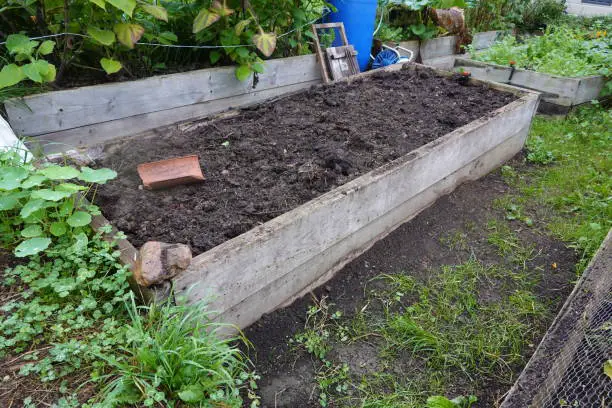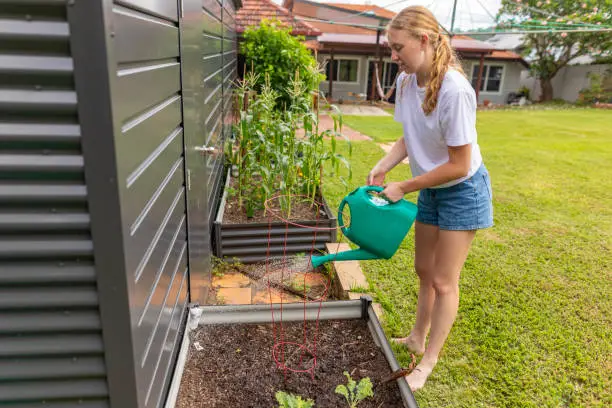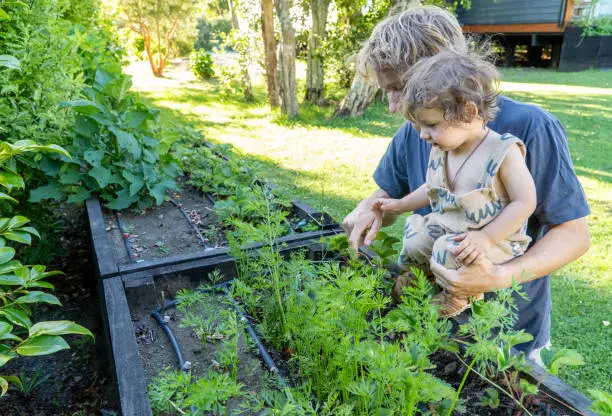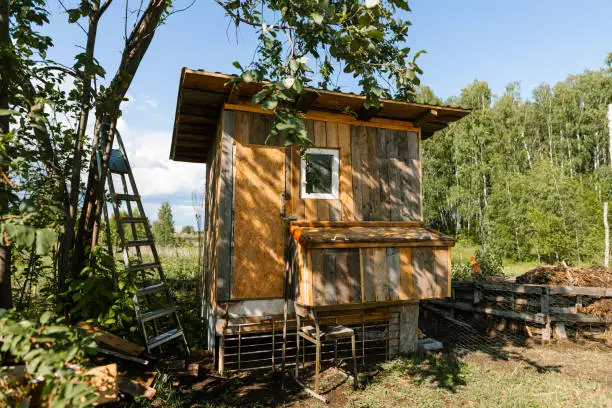Do you want to add raised vegetable beds to your backyard homesteading? You’ve found it. And guess what? You needn’t spend or waste. How can you construct these beauties with repurposed materials?
The Treasure Hunt Begins
Scavenge around your home first. In the corner, wooden pallets, bricks, and even rusted metal sheeting can be goldmines. A treasure hunt for adults! Check local ads or internet marketplaces; people often give away unwanted items.
Wooden Pallets: Gardeners’ Best Friend
Wooden pallets are everywhere and frequently free. They are easy to work with and robust. Check their safety before pounding. Look for “HT” (heat-treated) stamps instead of “MB” (methyl bromide), which is harmful to vegetables.
Disassemble the pallets using a crowbar or hammer before constructing. Arrange the planks in a desired rectangle and nail them. Voilà! You have a frame.
Bricks and cinder blocks: Good Choices
Do you have some old bricks or cinder blocks? They make great raised bed borders and can withstand extreme weather.
Please place them in a rectangle on level ground. Stack them two layers high for deeper soil beds if you’re feeling fancy. Gravity holds everything in place without nails or screws.

Tires aren’t just for cars.
Used tires are another excellent alternative for circular garden beds. They also give your backyard industrial chic.
No one wants automobile filth on their salad greens—clean them first! Fill them with soil for your garden bed. For extra depth, stack tires.
Rustic-modern metal sheets
Use your old corrugated metal sheets! They give your landscape a rustic-modern vibe.
Use tin snips to cut sheets into equal-length panels (wear gloves). Support your bed with wooden stakes at each corner and screw or nail the metal sheets.
Plastic bottles: eco-friendly innovation
Plastic bottles may become garden bed barriers! Get as many as you can; ask friends and neighbors.
Stack bottles horizontally in a wooden frame with sand or mud for stability. Hold them together with wire or zip ties. Reusing plastic garbage to grow fresh food is eco-friendly!
Soil Matters When Filling Beds
Fill your frames after building them! Start with cardboard or newspaper at the bottom to prevent weeds—my grandma swears by it!
Next is compost or aged manure, followed by quality topsoil with decomposed leaves or grass clippings. Your plants will appreciate it!
Grow what you love: Planting Tips.
The fun part is planting! Choose herbs and veggies you enjoy eating since you’ll be more likely to care for them.
Carrots, lettuce, tomatoes—anything! Position taller plants carefully in each bed to avoid overshadowing shorter ones.
Watering Wisdom: Simplify
Watering doesn’t have to be complicated, but consistency matters! Drip irrigation systems help if you miss watering schedules. Otherwise, get that hose every morning before the sun heats up!
Make sure to research each plant you’ve planted’s water needs—it’ll save you headaches!

Pest Patrol: Natural Defenses
Nobody wants uninvited guests eating their veggies, right? Plant broken eggshells around plants to dissuade slugs and marigolds to repel aphids!
Ladybugs are charming tiny warriors fighting pests, so release some in your garden!
Recycling items to build raised garden beds is rewarding and enjoyable! Consider all the fantastic homemade foods available during harvest season. That’s worth investigating.
A Homesteader’s Guide to Building a Backyard Greenhouse
You’ve chosen to build a backyard greenhouse. Great decision! This project is like planting a seed that will produce unlimited gardening options. Jump in and get messy.
First, location matters. You want plenty of sunlight but with some wind protection. Find Goldilocks’ happy spot—not too hot or cold.
The materials are discussed below. There is no need to spend a fortune. On a budget, PVC pipes and plastic sheeting work wonderfully. You can get fancier with timber frames and polycarbonate panels. Wood is durable and long-lasting, whereas PVC is lightweight and easy to install.
Sketch your design before hammering. A crude napkin drawing helps prevent headaches. Measure twice, cut once—this is advice from every DIY veteran.
It’s time for the foundation! Use concrete blocks or bricks to level and stabilize wood or metal frameworks. For PVC buildings, rebar anchors protect against wind gusts.
Now comes the exciting part—frame assembly! You’ll utilize this masterpiece regularly, making it more fulfilling than adult Lego. Secure your pieces—wobbly greenhouses are dangerous.
We’ll cover your frame next. Make sure plastic sheeting or polycarbonate panels are as snug as a bug on a rug. Fluttering covers might degrade over time.
We need fresh air. Thus, plants require ventilation, too! Install easy-to-open vents or windows. In the heat of summer, you don’t want to cook your plants.
Discuss shelves and storage in your new plant haven. Strong shelves will optimize space for all those pots and trays you’ll collect (believe me, you will). Vertical pegboards make tools easy to reach!
There is no need to worry about high-tech watering systems. Watering plants with drip irrigation can prevent you from becoming a flood zone manager.
Lighting can be crucial, especially during shorter winter days when tomatoes need more light than natural light. Find a grow light that meets your budget and space!
Heating may be needed depending on where the home base is located. Small portable heaters work well, while thermal mass objects like water-filled barrels absorb daytime heat and release warmth slowly overnight, creating a cozy greenhouse environment.
And voilà—you have a greenhouse to produce anything from delicate herbs to hearty veggies to flowers aplenty to exotic species thought impossible to grow outdoors in garden beds!
Maintenance tip: To prevent future tragedies, regularly inspect the building for tightness, especially after extreme weather events like storms and snowfalls.
Finally, have fun studying, exploring, and constructing your ideal backyard getaway where dreams practically grow before your eyes.
Raised garden beds change lives! Look for wooden pallets, bricks, tires, and metal sheets around your home or in local advertisements. Heat-treated wood pallets are ideal, not methyl bromide-treated. Disassemble, nail the rectangle, and be done! Stack bricks and cinder blocks in a rectangle; gravity does the rest. Cut metal sheets to size and stake them for rustic beds—clean used tires for circular beds. Sand-filled and stacked plastic bottles can create unique barriers.
After building your beds, add cardboard, compost, and dirt. Place your favorite herbs and vegetables so that the taller ones don’t shade the shorter ones. Regular watering is essential; drip irrigation helps. Plant marigolds to repel aphids and break eggshells to discourage slugs. Delight in homegrown veggies!
Building a backyard greenhouse is similarly satisfying. Choose a sunny, wind-screened area. Timber frames and polycarbonate panels are durable, but PVC pipes and plastic sheeting are cheap. Sketch your design with accurate measurements. Concrete blocks or rebar anchors form a solid base. Protect your frame with plastic sheeting or panels after assembly.





Leave a Reply
You must be logged in to post a comment.